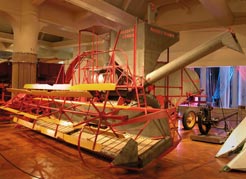
Considered to be the finest American collection of agriculture equipment, the exhibit includes an early John Deere plow, the first Fordson tractor, and one of the first gasoline-powered grain combines.
 | First Fordson Tractor
This is production model No. 1 of the Fordson tractor. Introduced in 1917, it was the first mass-produced and lightweight tractor made. Henry Ford had long been interesed in developing a tractor to meet the needs of the small farmer. Heralded as the "Model T of farm power," the first Fordsons were shipped to Great Britain to assist in that country's war effort. Following World War I, the Fordson rapidly became the most popular tractor in America. Nearly 750,000 had been produced - more than half of all tractors in the United States. Beginning in 1920, the Census Bureau began recording the enormous declines in the population of farm horses.
Henry Ford & Son, Inc. Dearborn, MI
Made: 1918
ID: 00.136.291 |
 | Massey-Harris Model 20 Combine
This machine opened a new era in farm mechanization and revolutionized the process of harvesting small grains, such as wheat, oats and barley. During the years following World War II, self-propelled machines such as this rapidly replaced tractor-drawn combines.
Massey-Harris Co., Ltd.
Toronto, Ontario, Canada
Made: 1938
ID: 75.131.1 |
 | Oliver Chilled Plow
In 1870, James A. Oliver sold his first "chilled" plow where the cast iron is cooled quickly with a stream of water to harden the metal. This made the iron harder than traditional cast iron, and allowed it to turn the earth more efficiently. By the 1890s, his was the largest plow works in the United States.
Oliver Chilled Plow Works produced about 250,000 plows in their first fifteen years, and the plow remained popular into the twentieth century. But by the 1930s, soil conservationists recognized that conventional plowing caused erosion from wind and water.
Oliver Chilled Iron Works, South Bend, IN
Made: ca.1895
ID: 00.1215.1 |